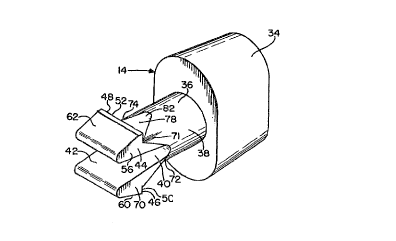Some of the information on this Web page has been provided by external sources. The Government of Canada is not responsible for the accuracy, reliability or currency of the information supplied by external sources. Users wishing to rely upon this information should consult directly with the source of the information. Content provided by external sources is not subject to official languages, privacy and accessibility requirements.
Any discrepancies in the text and image of the Claims and Abstract are due to differing posting times. Text of the Claims and Abstract are posted:
| (12) Patent: | (11) CA 2009054 |
|---|---|
| (54) English Title: | QUARTER-TURN DETENT TWISTLOCK |
| (54) French Title: | VERROU TOURNANT A CLIQUANT QUART DE TOUR |
| Status: | Deemed expired |
| (52) Canadian Patent Classification (CPC): |
|
|---|---|
| (51) International Patent Classification (IPC): |
|
| (72) Inventors : |
|
| (73) Owners : |
|
| (71) Applicants : | |
| (74) Agent: | FINLAYSON & SINGLEHURST |
| (74) Associate agent: | |
| (45) Issued: | 1998-12-22 |
| (22) Filed Date: | 1990-01-31 |
| (41) Open to Public Inspection: | 1990-08-09 |
| Examination requested: | 1994-09-29 |
| Availability of licence: | N/A |
| (25) Language of filing: | English |
| Patent Cooperation Treaty (PCT): | No |
|---|
| (30) Application Priority Data: | ||||||
|---|---|---|---|---|---|---|
|
A twistlock fastener is constructed of a latching member and a
base member. The base member has a socket portion with a
square-shaped internal bore. The latching member is formed with head
portion and a shank portion. The shank portion has a
cylindrical section adjacent to the head portion and has a pair
of resilient bifurcated leg elements integrally formed with the
cylindrical section. Each of the leg elements have a radial
surface to provide a latching shoulder. Each latching lateral
shoulder is formed with a width sufficient to retain the shank
portion in the square-shaped internal bore. Each of the opposite
side surfaces at the opposite ends of the latching shoulder for
both leg elements lie in a common flat plane which is
perpendicular to the latching shoulders. The surface on each of
the leg elements that extends axially from and adjacent to each
latching shoulder is flat, and the corner surfaces along each of
the leg elements adjacent to each of the opposite side surfaces
are rounded along the length of the leg elements.
Verrou tournant constitué d'un élément de verrouillage et d'un élément de base. L'élément de base possède un emboîtement présentant un alésage interne en carré. L'élément de verrouillage comprend une tête et une tige. La tige possède une section cylindrique qui est adjacente à la tête, ainsi qu'une paire de pattes bifurquées et résilientes formées intégralement avec la section cylindrique. Chacune des pattes présente une surface radiale fournissant un épaulement de verrouillage. Chaque épaulement latéral de verrouillage est de largeur suffisante pour retenir la tige dans l'alésage en carré. Chacune des surfaces latérales opposées aux extrémités opposées de l'épaulement de verrouillage des deux pattes repose en un plan plat commun qui est perpendiculaire aux épaulements de verrouillage. La surface de chacune des pattes s'étendant axialement depuis chacun des épaulements, et qui sont adjacentes à ceux-ci, est plane. Les surfaces de coin le long de chacune de ces pattes adjacentes à chacune des surfaces latérales opposées sont arrondies sur la longueur des pattes.
Note: Claims are shown in the official language in which they were submitted.
Note: Descriptions are shown in the official language in which they were submitted.

For a clearer understanding of the status of the application/patent presented on this page, the site Disclaimer , as well as the definitions for Patent , Administrative Status , Maintenance Fee and Payment History should be consulted.
| Title | Date |
|---|---|
| Forecasted Issue Date | 1998-12-22 |
| (22) Filed | 1990-01-31 |
| (41) Open to Public Inspection | 1990-08-09 |
| Examination Requested | 1994-09-29 |
| (45) Issued | 1998-12-22 |
| Deemed Expired | 2004-02-02 |
There is no abandonment history.
| Fee Type | Anniversary Year | Due Date | Amount Paid | Paid Date |
|---|---|---|---|---|
| Application Fee | $0.00 | 1990-01-31 | ||
| Registration of a document - section 124 | $0.00 | 1991-11-13 | ||
| Maintenance Fee - Application - New Act | 2 | 1992-01-31 | $100.00 | 1992-01-22 |
| Maintenance Fee - Application - New Act | 3 | 1993-02-01 | $100.00 | 1992-11-26 |
| Maintenance Fee - Application - New Act | 4 | 1994-01-31 | $100.00 | 1993-11-12 |
| Maintenance Fee - Application - New Act | 5 | 1995-01-31 | $150.00 | 1994-11-14 |
| Maintenance Fee - Application - New Act | 6 | 1996-01-31 | $150.00 | 1995-11-02 |
| Maintenance Fee - Application - New Act | 7 | 1997-01-31 | $150.00 | 1997-01-03 |
| Maintenance Fee - Application - New Act | 8 | 1998-02-02 | $150.00 | 1998-01-20 |
| Final Fee | $300.00 | 1998-08-10 | ||
| Maintenance Fee - Patent - New Act | 9 | 1999-02-01 | $150.00 | 1999-01-25 |
| Maintenance Fee - Patent - New Act | 10 | 2000-01-31 | $200.00 | 2000-01-04 |
| Maintenance Fee - Patent - New Act | 11 | 2001-01-31 | $200.00 | 2001-01-03 |
| Maintenance Fee - Patent - New Act | 12 | 2002-01-31 | $200.00 | 2002-01-03 |
Note: Records showing the ownership history in alphabetical order.
| Current Owners on Record |
|---|
| ILLINOIS TOOL WORKS INC. |
| Past Owners on Record |
|---|
| FRANO, FRANCIS G. |